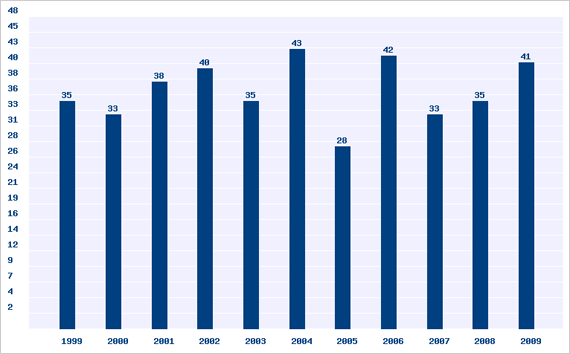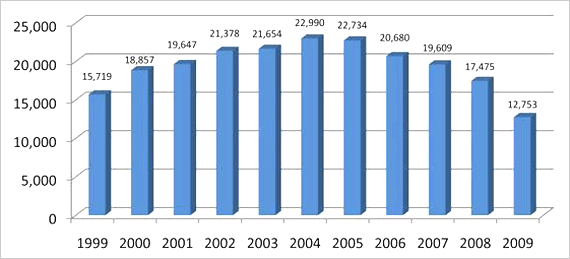Top>Research>Japan- Export Nation of Adoptive Children
 Index
Index

Yasuhiro Okuda [Profile]
Education course
Japan- Export Nation of Adoptive Children
Yasuhiro Okuda
Professor of Private International Law, Chuo Law School
Japanese babies heading to America
On June 1, 2010, we will hold a symposium on Striving for the enactment of an adoption service law at a conference room in the Lower House Chambers. Our group is made up of Rep. Seiko Noda (Liberal Democratic Party, Lower House), Rep. Kiyohiko Toyama (New Komeito, Lower House), Yomiuri Shimbun reporter Masaki Takakura (author of the book Price of Babies), Professor Hirohito Suzuki (Faculty of Law, Chuo University), and myself. We formed a study group four years ago, aiming to draft an adoption service law. Several tens of children per year head to the U.S. from Japan for adoption, and we wanted to stop the flow.
According to US Department of State, the number of adoptive children from Japan recorded each year for the period 1999-2009 was 35, 33, 38, 40, 35, 43, 28, 42, 33, 35 and 41, a combined total of more than 400. This number is exceptionally high for a developed nation. Western European countries such as Germany and France have a shortage of children for adoption, in the same way as the United States, and do not send them abroad. There are countries like China, Russia and South Korea who export over 1000 children to America, but even in these countries, the number is decreasing because they succeed in restraining intercountry adoptions by taking legislative and administrative measures. This can be seen in the reduction of the total amount of foreign adoptions in the U.S. to 12,753 in 2009 from its peak in 2004 of 22,990. At this rate, Japan, with no effective regulations, could become a target of adoption business.

Graph I: Number of visas issued by U.S. for adoption from Japan

Graph II: Number of visas issued by U.S. for adoption in total
Offered by: Office of Children's Issues, US Department of State: Intercountry Adoption![]()
Unwanted Pregnancies
In Japan, intercountry adoptions are arranged by private agencies. These agencies are legally obliged to submit notifications to the prefecture, but the regulation imposes no penalty. A notification system with no penalties is completely ineffective. 13 agents submitted notifications in 2008, while more than 20 did not, and regardless of submitting notifications or not, many of them are, or have been involved in foreign placements. But then, why do they send children to overseas?
If you search through newspaper articles, you may easily find a report about child abandonment almost every month. And, according to Ministry of Health, Labour and Welfare, while the total number of abortions is declining, abortions by minors are on the rise. We may assume that unwanted pregnancies are increasing. There are agencies who recommend foreign adoptions to young mothers who have past the abortion stage and their families, saying they will send the child far away.
They hand the babies over to foreigners who come to Japan on short term visas. Usually background checks of these prospective adoptive parents are inadequate, and agencies cannot even confirm whether the adoption procedure has been actually completed. Media report fears of human trafficking, child pornography and organ trading for the orphans of the Haitian earthquake. Japanese children are facing the same kind of danger.
We need professionals
Agencies who engage in placements within national borders also have problems. They take newborns from their mothers in the hospital and hand them over to prospective adoptive parents, saying they have the mother's consent. They claim that newborns will probably attach themselves to anybody, without actually conducting a thorough matching process to find suitable adoptive parents. Families are chosen just because “they look like good people” or “they live decent life”. Poor matching procedure can be seen in both domestic and foreign adoptions.
When hearing the word agency, an image of a corrupt broker may come to mind. But adoption agencies are not necessarily so. There are agencies who demand large monetary donations (there has been a case of demanding $45,000 from an adoptive parent applicant). On the other hand, some agencies ask only for delivery costs on behalf of the birth mother. But, no matter how good the intentions are, we must regulate by law adoption service of agencies that controls the fate and even the life of children. Instead of current notification system, we need a licensing system.
The most important qualification for the license is to have a staff specializing in welfare. Social welfare workers (Shakai Fukushi-shi) may be suitable under the current legal system of Japan. These specialists must give counseling to concerned parties, confirm some important points (necessity of adoption arrangement, birth parent's consent, matching of children and adoptive families, supervised trial custody, post-adoption service, etc), and report all results to the prefecture. This is to make sure that the adoption placement is in the best interests of the child. Of course, unjustified monetary enrichment would be illegal. For this purpose the Ministry of Health, Labour and Welfare needs to provide concrete standards to calculate costs involved in adoption placements.
The role of child guidance centers
So what role must child guidance center (CGC, Jidô Sôdansho) as a public section of each prefecture play in adoption placements? In these years, there are many couples who fail infertility treatment and wish to adopt a child. For these prospective adoptive parents, the services of CGC are not totally satisfactory. Children with their birth parent's consent for adoption are very few, and even after waiting many years, not so many children are actually introduced. CGC also claims that an adoptive child must be at least two years of age to determine his or her disability, so babies are rarely put forward.
Parents who cannot raise their child also hesitate to bring their case to CGC. It does not provide pre-birth counseling, limits the adoption to be within the prefecture, and is slow in making decisions. As a result, unwanted babies are handed over to private agencies, and sometimes end up overseas.
Among the agencies, there are some who cooperate with CGC and search for adoptive parents in Japan. Unfortunately these agencies are few, and parents who do not know these agencies or live far away are often at their wit's end and abandon their child. Therefore it is essential that all CGCs to be more involved in adoption placements.
We suggest that each prefecture should have at least one center with specialist personnel and strengthen cooperation with other prefectures and private agencies. Each CGC should respond to approach from parents before birth and swiftly contact, if necessary, the center with specialist personnel. In addition, the Ministry of Health, Labour, and Welfare should set guidance to provide information for adoptive parents and speed up the adoption process.
Necessity of an adoption service law
In Japan adoptions generally have been taken place among blood-relatives. Although approximately 90000 adoptions in total take place every year, adoptions of minors from other families account for less than three percent of the total. Special adoptions (Tokubetsu Yôshi-engumi) which terminate legal relationship of children with birth parents must be finalized by adoption decree of the family court, and even in regular adoptions (Futsû Yôshi-engumi) cases of minors coming from other families must gain permission from the family court. The Japanese government claims that the best interests of the child are properly protected by the family court. But the family court starts to consider the case only after filing of the parties concerned, with a passive attitude. Furthermore, there is no follow-up on the well-being of the child by the family court after the adoption has been legally established.
When adopting minors from other families, somebody other than the family court must provide the service such as matching of a new family and assisting the legal procedure. Japanese children are adopted abroad not because of a lack of possible adoptive parents in Japan. Rather, the reason is that there are few opportunities for two sides (adoptive children and families) to meet, and arrangements are not functioning well. If arrangements do function within Japan, the number of foreign adoptions will decrease naturally, and Japan will be no more export nation of children. For this purpose we need a law to promote adoption service in an appropriate manner in Japan.
There are many countries, such as Germany and South Korea, which have established adoption service laws in addition to laws determining the requirements for legally establishing the adoption such as adoption decree of the court or filing at the civil registration office. Other countries such as Anglo-American countries and Philippines set up both rules of adoption service and requirements for legal adoption in a single law. In other words, many countries have both adoption laws as family laws and adoption service laws as child welfare laws simultaneously. But we only have an adoption law as family law. Japan as a country exporting adoptive children definitely needs its own adoption service law.
- Yasuhiro Okuda
Professor of Private International Law, Chuo Law School - Born in Hyogo Prefecture in 1953. Received his Master's Degree from Kobe University Graduate School of Law. Entered his current position in 2004 after working as an assistant professor at Kagawa University and professor at Hokkaido University. His wide scope of research includes international family law, nationality law and international business law. His major publications include Nationality Law and International Child Law (Yuhikaku Publishing Co. 2004), Study on Private International Law and Related Laws (Chuo University Press, 2009), and Collection of Legal Opinions on Nationality Law and International Family Law (Chuo University Press, 2010).
- Research Activities as a Member of Research Fellowship for Young Scientists (DC1), Japan Society for the Promotion of Science (JSPS) Shuma Tsurumi
- Important Factors for Innovation in Payment Services Nobuhiko Sugiura
- Beyond the Concepts of Fellow Citizens and Foreigners— To Achieve SDGs Goal 10 “Reduce Inequality Within and Among Countries” Rika Lee
- Diary of Struggles in Cambodia Fumie Fukuoka
- How Can We Measure Learning Ability?
—Analysis of a Competency Self-Assessment Questionnaire— Yu Saito / Yoko Neha - The Making of the Movie Kirakira Megane








